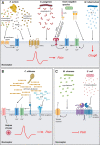Microbes and pain
- PMID: 33793668
- PMCID: PMC8016104
- DOI: 10.1371/journal.ppat.1009398
Microbes and pain
Conflict of interest statement
The authors have declared no competing interests exist.
Figures

References
-
- Sherrington CS. The integrative action of the nervous system. New York: C. Scribner’s sons; 1906. xvi, 411 p.
Publication types
MeSH terms
Grants and funding
LinkOut - more resources
Full Text Sources
Other Literature Sources
Medical

